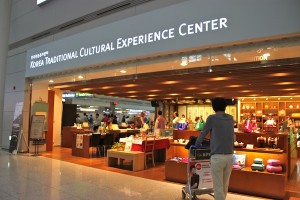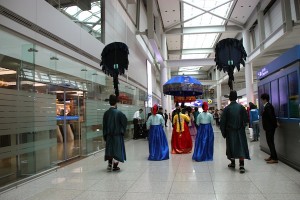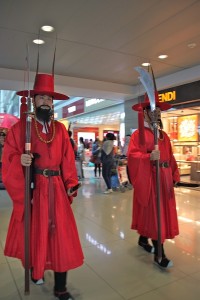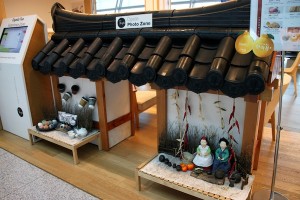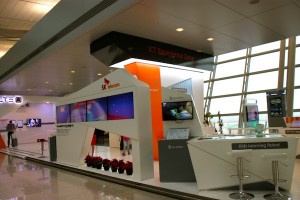No one wants a long layover or a long wait for a flight anywhere for any reason. However, my recent several spare hours at the Incheon International Airport in Seoul, Korea, were about as good as a long wait gets.
With time to kill, I stumbled onto something called the Korea Traditional Cultural Experience Center.
And that’s what it was. Examples of Korean arts were on display (some for sale) in one section. At tables in another section, hosts in traditional dress assisted visitors trying their hand at one or another traditional craft. These activities could include making painted fans, pencil cases, jewelry boxes or other items the visitors could take home as souvenirs.
There was a small stage in the corner of this experience center, but it was vacant when I saw it. I learned later (I learned a lot of things later!) that travelers sometimes see demonstrations of traditional dances and musical instruments on this stage.
But I did see one show.
Suddenly, a dozen or more men and women appeared in garments typical of the last Korean royals, the Choson (or Joseon) Dynasty (1392-1910). They paraded very slowly through the airport in what was described as the Walk of the Royal Family, further described in on-site signage as a reenactment of a typical event from the early Choson days.
This had me scrambling to unpack and reassemble my camera (already carefully packed away for travel) to get a few shots of something I had never seen before in an airport. The posted signage said the walk occurs three times daily and takes an hour… plenty of time for many passengers to get an eyeful.
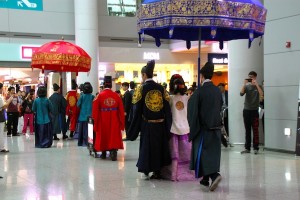
Royal Walk: Passengers take note, and photos, as reenactors begin their procession at Incheon International Airport.
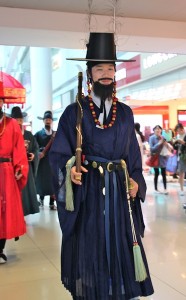
Royal Walk: Ditto for this guy in the great costume with a cudgel in his right hand and a sword in his left.
There are five cultural experience centers at Incheon, three positioned near departure gates and two in the transit lounges.
The Korea Cultural Heritage Foundation organizes these cultural experiences to enlighten foreign passengers about traditional Korean culture, the foundation says.
The sponsors are the country’s Cultural Heritage Administration, its Ministry of Culture, Sports and Tourism and the airport itself.
There is more to this effort, all of which I learned about later.
There are a few Korean Cultural Streets in the terminals, which show off traditional architecture; the Cultural Museum of Korea (in the transfer lounges, operated with the National Museum of Korea); traditional craft displays in the transfer lounges, and the Millennium Hall for cultural performances representing all eras (in the duty-free area).
That’s an impressive package of diversions to entertain passengers while Korea shows off its culture. These displays and activities leave departing tourists with a positive last impression but may be an introduction for those in transit lounges.
The airport itself, besides being modern, attractive and spacious, is a form of entertainment, too. I refer to themed cafes and shops — and even trade show-quality exhibitions — to be found on the concourses. My photos here illustrate that.
Signage at the airport boasts that passengers have rated Incheon as the world’s top airport several times. I can certainly understand some of the reasons.
However, I give the facility one demerit. After passing through security, I could not find a chair or table to use while putting my laptop back into its bag.
But, nothing is perfect, right? Aside from that one quibble, the airport approached perfection.
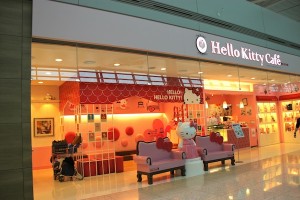
Themed spots like this Hello Kitty Cafe entertain the kids in all passengers. There is a Charlie Brown Cafe nearby, too.
For more about South Korea, we offer at BestTripChoices.com the following, under the headline: South of the DMZ https://besttripchoices.com/international-countries/south-korea/
This blog and photos are by Nadine Godwin, BestTripChoices.com editorial director and contributor to the trade newspaper, Travel Weekly. She also is the author of “Travia: The Ultimate Book of Travel Trivia.”

